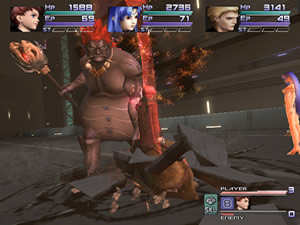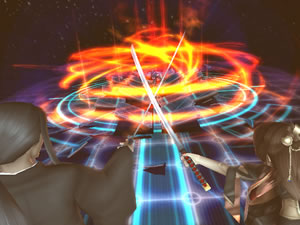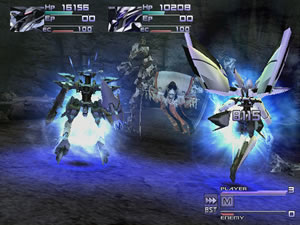Lost in space.
Once upon a time, a cut-scene was considered a mind-blowing leap of technology. Not only did the cut-scene feature fancy graphics and sound, but it propelled the increasing importance of storytelling in games to new heights. It came to be that an RPG without cool cut-scenes was an RPG no one would care to play.
But what happens when this lauded game device gets ahead of itself? Well, we wind up with something like the Xenosaga series.
In the preposterously titled Xenosaga Episode II:
Jenseits von Gut und Bose, the impressive cut-scenes work in tandem with excessive loading to get in the way of the gameplay. Like Xenosaga before it, this anticipated sequel will ask you repeatedly to put down the controller, sit still, and watch. This might appease fans of the series who are just dying to find out more about the epic universe, but it doesn’t make for a great game.
In the outer reaches of space, different political and military factions vie for control. They are searching for the Zohar, a monolithic artifact that holds the key to salvation’or possibly destruction. A band of scientists, robots, warriors, and genetic creations from vastly different backgrounds find their lives drawn together in a quest for this mystical artifact. There’s Shion, a work-absorbed scientist with an emotionally immature robot companion named KOS-MOS, and MOMO, a bright-eyed, cheery little girl, who is actually a Realian. She clings to Ziggy, a resurrected bodyguard who is more machine than man.
These characters share little in common outside of their common quest, and a hatred for their parents for giving them such retarded names.
Much of the game, though, forgoes its epic nature and closely follows a few characters. The story is largely episodic and plays out just like an anime series. There are some strong sequences, but these are mostly offset by thematic clich’s. While the moments of high tension can be quite engaging, the bulk of the plot is tedious and overwrought. The dialogue is also a bit opaque thanks to all the confusing sci-fi names, pretentious terminology, and random religious references.
Since Xenosaga II picks up right after the original, it begins in the middle of a story with many questions still left unanswered, so if you haven’t played the first game you won’t have any idea what is going on. Thankfully, occasional flashbacks help clarify the overly complicated parts. These revelatory backstories help explain why the characters act the way they do and lend insight into the motives of the supreme “bad” character. His evil is predicated on his past, instead of the fact that he has white hair.
 Xenosaga‘s turn-based fighting system has been refined. It’s all about zones; enemies have up to three zones designating different regions of their body. When you figure out the enemy’s weakest region, you can focus your combo attacks properly. Your characters’ turns can also be skipped to stock up on more powerful moves, appropriately called “Stocks’. These enable the burlier attacks and look awesome. Other new features include team-oriented “boost” commands and the ability to swap characters before the enemy’s turn for more shots. If it sounds different, it is, and different is good.
Xenosaga‘s turn-based fighting system has been refined. It’s all about zones; enemies have up to three zones designating different regions of their body. When you figure out the enemy’s weakest region, you can focus your combo attacks properly. Your characters’ turns can also be skipped to stock up on more powerful moves, appropriately called “Stocks’. These enable the burlier attacks and look awesome. Other new features include team-oriented “boost” commands and the ability to swap characters before the enemy’s turn for more shots. If it sounds different, it is, and different is good.
It’s also confusing. There aren’t always clear-cut strategies and maneuvers, so you’ll have to feel out which characters and moves are the most effective against which enemies, instead of relying on the old water-kills-fire elemental equation. In a nice touch, battles aren’t random; you can see and often avoid confrontation. You cannot, though, avoid the long loading times before a battle starts. Bummer.
In an odd change from the previous game, money has been taken out of Xenosaga II completely. If you want to gain new items, you have to fight for ’em. An RPG of this scope without a decent economic model definitely feels like a step backward.
Xenosaga II falls prey to another pet peeve of mine ” looping, mindless NPCs. Watching a guy wait for a bus that will never come is very sad. In this post-GTA age, we expect a little more out of our immersive worlds.
Nonetheless, the game’s environments are slick, futuristic and stylish. Highly polished and reflective metals and sterile, inorganic designs create a believable universe far beyond The Jetsons. The decidedly overexaggerated character designs of the first game have been toned down a few notches for a less extreme look. The result is a better artistic direction that creates more believable characters and, by proxy, better “acting” and emotions. Coupled with the groovy environments, the game’s graphics are sharp and impressive.
 The sound is far less striking but gets the job done, with plenty of ambient, moody music (although one track sounds like a ringing alarm clock). Thankfully, the effects are accurate and the voice-acting is strong. Some voices lean on the monotone side, presumably to help relate the robotic nature of many characters.
The sound is far less striking but gets the job done, with plenty of ambient, moody music (although one track sounds like a ringing alarm clock). Thankfully, the effects are accurate and the voice-acting is strong. Some voices lean on the monotone side, presumably to help relate the robotic nature of many characters.
In a story filled with robots and genetic creations questioning their own existence, Xenosaga II poses one serious question about itself: Is Xenosaga a video game with obscenely long cutscenes or is Xenosaga actually an anime series injected with some gameplay? Unfortunately, it’s more the latter than it should be.
Despite a big, engrossing story and some improved combat features, this second step in the Xenosaga series doesn’t manage to live up to its prior success. Hopefully, the next game will tone down the excessive storytelling segments and continue refining the combat. If you haven’t played the first game, don’t jump in now. Think it over, decide if you have the patience, and start back at the beginning. Just be prepared to sit.
-
Improved combat
-
New character designs
-
Continues to flesh out the immense plot
-
Through too many long cut-scenes
-
Pacing problems
-
Lots of cliches
-
More anime than game











